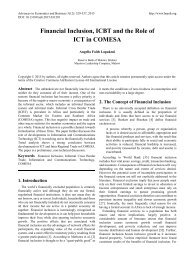FD
gvti301SEaf
gvti301SEaf
Create successful ePaper yourself
Turn your PDF publications into a flip-book with our unique Google optimized e-Paper software.
Lin, corrected 04/25/2016<br />
reached its 2008 level only in 2015 (see Chart 2). In other<br />
words, the euro area continues to suffer from too few workers<br />
and too little investment.<br />
The area also suffers from weak productivity growth (that<br />
is, output per worker hour). Empirical studies find that slow<br />
progress in improving the efficient use of labor and capital in<br />
the euro area, particularly in the service sector, bears most of<br />
the blame for a widening gap in productivity with the United<br />
Lower potential growth makes it<br />
harder to bring down debt.<br />
States. Slower efficiency improvements and lower productivity<br />
growth in services in turn reflect delayed adoption and<br />
diffusion of information and communications technology.<br />
Unlike in the United States, where output per service sector<br />
employee has surpassed its precrisis peak, growth in the euro<br />
area has been gradual, and productivity remains below its<br />
precrisis peak in countries such as Germany and Italy.<br />
Moreover, gains in the efficient use of labor and capital in<br />
the United States are likely to slow in the future, which will<br />
probably affect other advanced economies (IMF, 2015). In<br />
addition, adopting and promoting innovation call for flexibility<br />
and adaptability. Without swift action to address structural<br />
problems in the euro area—such as difficulties in firing workers<br />
or cutting wages and a business environment unfriendly to<br />
start-ups—diffusion of new technology may be delayed.<br />
Crisis legacies linger<br />
Some problems, such as high unemployment and high public<br />
and private debt, predate the crisis. While the return to<br />
modest growth should help address these problems to some<br />
extent, without decisive policies to improve growth prospects<br />
and reinvigorate investment, unemployment and debt will<br />
remain a drag on economic growth. High debt could hold<br />
back new investment, and high unemployment could arrest<br />
human capital development (by delaying investment in education<br />
and health, for example).<br />
The euro area unemployment rate remains high, especially<br />
for youth and the long-term jobless, raising the risk of skill<br />
erosion and entrenched high unemployment. Despite recent<br />
improvement, the unemployment rate remains above 10 percent<br />
in the euro area and much higher in some countries—<br />
for example, nearly 25 percent in Greece. Among those<br />
unemployed in the euro area, more than half have been out<br />
of a job for more than 12 months—a proportion of the unemployed<br />
ranging from a low of about one-quarter in Finland to<br />
nearly three-quarters in Greece. High youth unemployment<br />
could also give rise to a “lost generation” of workers.<br />
Over the medium term, the so-called natural rate of unemployment—the<br />
rate at which demand for and supply of<br />
workers are in equilibrium and employment and wage developments<br />
do not create inflation pressure—is projected to<br />
Chart 1<br />
Falling behind<br />
The gap between output per person in the euro area and in<br />
the United States is the biggest since Europe’s Economic<br />
and Monetary Union started in 1991.<br />
(real GDP per person, index, 1991 = 100)<br />
150<br />
140<br />
United States<br />
130<br />
Euro area<br />
120<br />
Lin, 110corrected 04/12/2016<br />
Japan<br />
100<br />
90<br />
1991 95 99 2003 07 11 15<br />
Sources: IMF, World Economic Outlook; and author’s calculations.<br />
Note: Real GDP is nominal GDP adjusted to account for inflation.<br />
Chart 2<br />
Slow recovery<br />
Nonresidential investment in the euro area did not return to<br />
the precrisis level until the end of 2015.<br />
(net nonresidential investment, 2015:Q4; index, 2008:Q1 = 100)<br />
120<br />
110<br />
100<br />
90<br />
80<br />
70<br />
60<br />
50<br />
40<br />
Sources: Eurostat; and author’s calculations.<br />
Greece<br />
Portugal<br />
Italy<br />
Japan<br />
Euro area<br />
Spain<br />
Germany<br />
France<br />
United Kingdom<br />
United States<br />
remain higher in Italy than during the crisis and decline very<br />
slowly in France. While the natural rate is expected to fall in<br />
Spain, it is still expected to remain above 15 percent over the<br />
next five years. In one scenario, for the euro area as a whole,<br />
based on historical relationships between output and unemployment,<br />
it could take about four years to reduce the unemployment<br />
rate to the average 2001–07 level without a persistent<br />
pickup in growth. It would take even longer for countries with<br />
higher unemployment and/or lower growth (such as Greece,<br />
Italy, Portugal, and Spain). Effective implementation of ongoing<br />
structural reforms could reduce that time by raising potential<br />
growth and/or making hiring more responsive to growth.<br />
In addition to high public debt, which makes it difficult<br />
for countries to use spending and tax policy to stimulate<br />
the economy, private sector debt must be further reduced<br />
to enable new investment. Nonfinancial corporate debt-toequity<br />
ratios have fallen in most euro area countries as firms<br />
have paid down borrowing. However, the debt reduction in<br />
many cases was accompanied by a cut in investment, a sharp<br />
increase in saving, and higher unemployment. In earlier episodes<br />
of significant corporate debt reduction, IMF research<br />
Finance & Development June 2016 53














